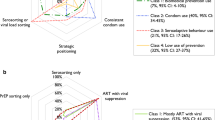Abstract
We compare estimates of multiple and concurrent sexual partnerships from Demographic and Health Surveys (DHS) with comparable Population Services International (PSI) surveys in four African countries (Kenya, Lesotho, Uganda, Zambia). DHS data produce significantly lower estimates of all indicators for both sexes in all countries. PSI estimates of multiple partnerships are 1.7 times higher [1.4 for men (M), 3.0 for women (W)], cumulative prevalence of concurrency is 2.4 times higher (2.2 M, 2.7 W), the point prevalence of concurrency is 3.5 times higher (3.5 M, 3.3 W), and the fraction of multi-partnered persons who report concurrency last year is 1.4 times higher (1.6 M, 0.9 W). These findings provide strong empirical evidence that DHS surveys systematically underestimate levels of multiple and concurrent partnerships. The underestimates will contaminate both empirical analyses of the link between sexual behavior and HIV infection, and theoretical models for combination prevention that use these data for inputs.


Similar content being viewed by others
References
Eaton JW, Hallett TB, Garnett GP. Concurrent sexual partnerships and primary HIV infection: a critical interaction. AIDS Behav. 2010;15(4):687–92.
Goodreau SM, Cassels S, Kasprzyk D, Montano DE, Greek A, Morris M. Concurrent partnerships, acute infection and HIV epidemic dynamics among young adults in Zimbabwe. AIDS Behav. 2012;16(2):312–22.
Powers KA, Ghani AC, Miller WC, et al. The role of acute and early HIV infection in the spread of HIV and implications for transmission prevention strategies in Lilongwe, Malawi: a modelling study. Lancet. 2011;378(9787):256–68.
Demographic and health surveys. 2012. http://www.measuredhs.com/publications/publication-FR194-DHS-Final-Reports.cfm.
Morris M, Epstein H, Wawer M. Timing is everything: international variations in historical sexual partnership concurrency and HIV prevalence. PLoS ONE. 2010;5(11):e14092. doi:14010.11371/journal.pone.0014092.
Central Statistical Office (CSO), Ministry of Health (MOH), Tropical Diseases Research Centre (TDRC), University of Zambia, Inc. MI. Zambia demographic and health survey 2007. Calverton, MD, USA: CSO and Macro International Inc.; 2009.
Kenya National Bureau of Statistics, ICF Macro. 2008–09 Kenya demographic and health survey. Calverton, MD, USA: KNBS and ICF Macro; 2010.
Ministry of Health and Social Welfare (MOHSW) [Lesotho], ICF Macro. Lesotho Demographic and Health Survey 2009. Maseru, Lesotho: MOHSW and ICF Macro; 2010.
Uganda Bureau of Statistics (UBOS), Macro International Inc. Uganda Demographic and Health Survey 2006. Calverton, MD, USA: UBOS and Macro International Inc.; 2007.
UNAIDS Reference Group on Measurement and Modeling. HIV: consensus indicators are needed for concurrency. Lancet. 2010;375(9715):621–2.
Hamilton D, Morris M. Consistency of self-reported sexual behavior in surveys. Arch Sex Behav. 2010;39(4):842–60.
Schoumaker B. Omissions of births in DHS birth histories in sub-Saharan Africa: measurement and determinants. Population Association of America. Washington, DC, 2011.
Reniers G, Watkins S. Polygyny and the spread of HIV in sub-Saharan Africa: a case of benign concurrency. Aids. 2010;24(2):299–307.
Dunkle KL, Stephenson R, Karita E, et al. New heterosexually transmitted HIV infections in married or cohabiting couples in urban Zambia and Rwanda: an analysis of survey and clinical data. Lancet. 2008;371(9631):2183–91.
Magadi M, Desta M. A multilevel analysis of the determinants and cross-national variations of HIV seropositivity in sub-Saharan Africa: evidence from the DHS. Health Place. 2011;17(5):1067–83.
Acknowledgments
We would like to thank Measure DHS for generously sharing the data. Our special thanks go to these particular PSI researchers and to all who have contributed significantly to the study designs and data collection: Amy Kate Herman-Roloff; Noah Taruberekera; Lipolelo Mokhesi; Peter Buyungo; Nicholas Shiliya; Felton Mpasela; and Edna Ogada.
Author information
Authors and Affiliations
Corresponding author
Electronic supplementary material
Below is the link to the electronic supplementary material.
Rights and permissions
About this article
Cite this article
Morris, M., Vu, L., Leslie-Cook, A. et al. Comparing Estimates of Multiple and Concurrent Partnerships Across Population Based Surveys: Implications for Combination HIV Prevention. AIDS Behav 18, 783–790 (2014). https://doi.org/10.1007/s10461-013-0618-6
Published:
Issue Date:
DOI: https://doi.org/10.1007/s10461-013-0618-6




